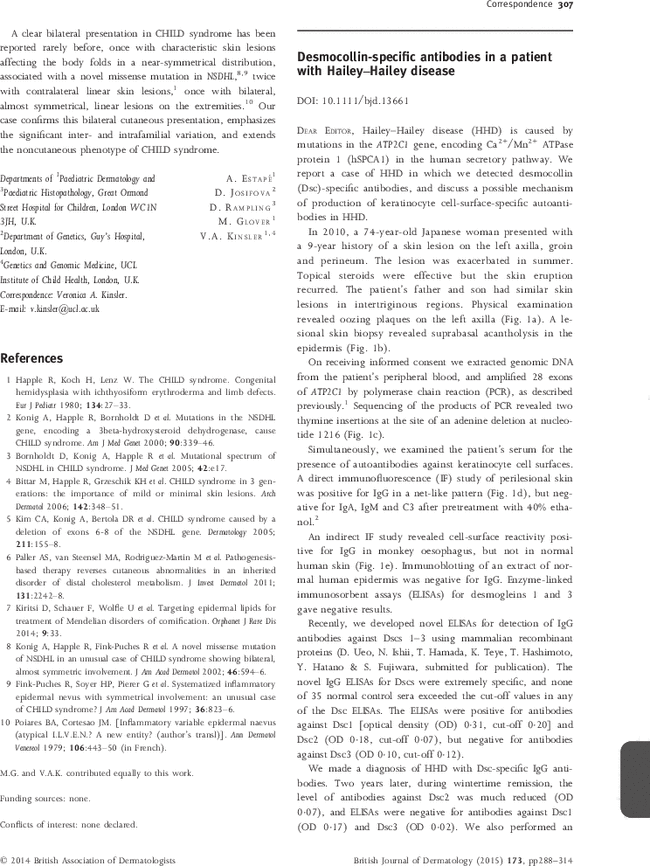Desmocollin-specific antibodies in a patient with Hailey–Hailey disease
N. Ishii
Department of Dermatology, Kurume University School of Medicine, and Kurume University Institute of Cutaneous Cell Biology, Kurume, Fukuoka, 830-0011 Japan
Search for more papers by this authorT. Hamada
Department of Dermatology, Kurume University School of Medicine, and Kurume University Institute of Cutaneous Cell Biology, Kurume, Fukuoka, 830-0011 Japan
Search for more papers by this authorK. Teye
Department of Dermatology, Kurume University School of Medicine, and Kurume University Institute of Cutaneous Cell Biology, Kurume, Fukuoka, 830-0011 Japan
Search for more papers by this authorT. Hashimoto
Department of Dermatology, Kurume University School of Medicine, and Kurume University Institute of Cutaneous Cell Biology, Kurume, Fukuoka, 830-0011 Japan
Search for more papers by this authorY. Hatano
Department of Dermatology, Faculty of Medicine, Oita University, Hasama, Yufu, Oita, 879-5593 Japan
Search for more papers by this authorCorresponding Author
S. Fujiwara
Department of Dermatology, Faculty of Medicine, Oita University, Hasama, Yufu, Oita, 879-5593 Japan
Correspondence: Sakuhei Fujiwara.
E-mail: [email protected]
Search for more papers by this authorN. Ishii
Department of Dermatology, Kurume University School of Medicine, and Kurume University Institute of Cutaneous Cell Biology, Kurume, Fukuoka, 830-0011 Japan
Search for more papers by this authorT. Hamada
Department of Dermatology, Kurume University School of Medicine, and Kurume University Institute of Cutaneous Cell Biology, Kurume, Fukuoka, 830-0011 Japan
Search for more papers by this authorK. Teye
Department of Dermatology, Kurume University School of Medicine, and Kurume University Institute of Cutaneous Cell Biology, Kurume, Fukuoka, 830-0011 Japan
Search for more papers by this authorT. Hashimoto
Department of Dermatology, Kurume University School of Medicine, and Kurume University Institute of Cutaneous Cell Biology, Kurume, Fukuoka, 830-0011 Japan
Search for more papers by this authorY. Hatano
Department of Dermatology, Faculty of Medicine, Oita University, Hasama, Yufu, Oita, 879-5593 Japan
Search for more papers by this authorCorresponding Author
S. Fujiwara
Department of Dermatology, Faculty of Medicine, Oita University, Hasama, Yufu, Oita, 879-5593 Japan
Correspondence: Sakuhei Fujiwara.
E-mail: [email protected]
Search for more papers by this author
References
- 1Hamada T, Fukuda S, Sakaguchi S et al. Molecular and clinical characterization in Japanese and Korean patients with Hailey–Hailey disease: six new mutations in the ATP2C1 gene. J Dermatol Sci 2008; 51: 31–6.
- 2Makhneva N, Beletskaya LV. Fixed and soluble immune complexes in the epidermis in Hailey–Hailey disease. J Dermatol 2007; 34: 410–12.
- 3Bennani I, Ofaiche J, Uthurriague C et al. [Antidesmoglein antibodies in a patient with Hailey–Hailey disease]. Ann Dermatol Venereol 2012; 139: 621–5 (in French).
- 4Tateishi C, Tsuruta D, Nakanishi T et al. Antidesmocollin-1 antibody-positive, antidesmoglein antibody-negative pemphigus herpetiformis. J Am Acad Dermatol 2010; 63: e8–10.
- 5Endo Y, Tsujioka K, Tanioka M et al. Bullous dermatosis associated with IgG antibodies specific for desmocollins. Eur J Dermatol 2010; 20: 620–5.
- 6Zhang D, Li X, Xiao S et al. Detection and comparison of two types of ATP2C1 gene mutations in Chinese patients with Hailey–Hailey disease. Arch Dermatol Res 2012; 304: 163–70.
- 7Cialfi S, Oliviero C, Ceccarelli S et al. Complex multipathways alterations and oxidative stress are associated with Hailey–Hailey disease. Br J Dermatol 2010; 162: 518–26.




